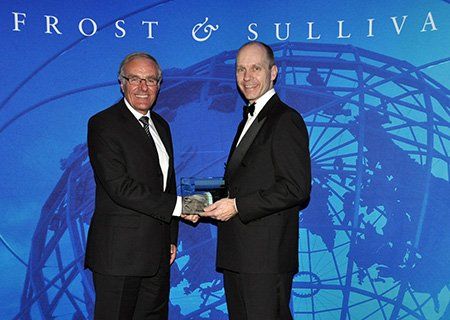Innovation and Excellence in Engineering
ISCC - Integrated Solar Combined Cycle
ISCC power plants use solar-generated heat together with the waste heat from a gas turbine in a steam turbine to generate electricity.
In 1999 the German KfW, together with the World Bank decided to promote the ISCC technology with a grant of USD 200 million. However, the World Bank considered halting the grant when opponents to the solar technology presented false thermodynamic calculations, that pretended a reduction of the efficiency.
Georg Brakmann succeeded in a debate in Washington, to convince the assembled body of the World Bank and KfW of the correctness of his own thermodynamic calculations and to uncover the error in the calculations of the opponents.
As a result the grant was activated, and the ISCC power plants in Morocco and in Egypt were built as designed and engineered by Georg Brakmann.
In 2011 Georg Brakmann received the prestigious Frost & Sullivan
“Green Excellence in Technology Innovation Award".
Conversion of Coal to Storage Power Plants
Coal Power Plants do not need to be shut down; they can be converted to Energy Storage Plants. This maintains the security of electricity supply, the jobs and the investments; at the same time the climate will be protected.
Only the coal-fired steam generator needs to be replaced by a steam generator powered by hot molten salt. The remaining part of the coal power plant can continue with the original steam parameters and the original operating crew.
Excess electricity from renewables will be used to heat the molten salt. Upon demand, the energy stored in the hot molten salt will be used to generate steam and electricity.
Molten salt energy storage has been operated successfully for over ten years in most of the 5,000 MWe concentrated solar power (CSP) plants worldwide; the technology is proven and readily available to convert coal fired power plants to storage power plants.
SolEngCo has the experience and references with molten salt energy storage and is ready to assist owners of coal power plants to save the jobs and the investments, to secure the electricity supply and to protect the climate.
ISCC Ain Beni Mathar, Morocco
Feasibility study, design, specification, tendering, selection of EPC bidders, supervision of engineering, procurement, construction and commissioning for this 472 MWe Integrated Solar Combined Cycle Power Plant in Morocco.
Site Investigation for Solar Power Plants, Brazil
An initial identification of twelve potential sites for further investigation was obtained by helicopter sighting over Brazil’s main ecoregions “Caatinga” and “Cerrado”.
These were further investigated during a second field visit by car and their suitability was ranked based on SolEngCo’s guidelines “Site Selection for large Solar Power Plants”.
Professional Training
Professional Training to International Organizations:
- China Renewable Energy Scale-up Program (CRESP)
- Northwestern Polytechnical University of Xian (China)
- Czech Technical University in Prague
- CSPPlaza, Beijing, China
- CSP Today, South Africa
ISCC Kuraymat, Egypt
Feasibility study, design, specification, tendering, selection of EPC bidders for Solar and for Combined Cycle Islands, management of interfaces, supervision of engineering, procurement, construction and commissioning for this 125 MWe Integrated Solar Combined Cycle Power Plant in Egypt.
320 MWe Solar Power Plant in Arizona, USA
200,000 tons of salt for the thermal energy storage and a solar field of 5 km * 3 km are a special kind of challenge to the art of engineering.
With this, we wanted to ensure that at peak times in summer, even after sunset, when the last air conditioning systems in Los Angeles are switched on, the solar electricity is generated with 95% security of supply and that the project is also economically very interesting due to the then high tariffs.
Solar Rooftop Plant in Göttingen, Germany

The solar rooftop plant is designed for a maximum electricity yield on the available roof area.
24 PV modules each 400 Wp are mounted on the flat roof in east-west orientation. In contrast to conventional designs, the PV modules of the outer rows near the attic wall are inclined inwards at a steeper angle; this minimizes shading and increases the electricity yield.
8.200 kWh/a solar electricity from one roof
Enough electricity for two homes
Hydrogen Application
H2/O2 Steam Generator for frequency stabilization and for security of power supply during longer dark periods.
High pressure steam for the turbine can be obtained by burning hydrogen with oxygen. Water is added in the appropriate quantity to obtain the desired steam conditions.
The prototype of the H2/O2 steam generator delivered the full power of 40 MWth within one second.







































